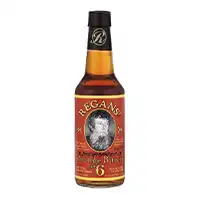Everyone’s heard of bitters. Even if you’ve never used them you probably have a bottle floating around your house. They get bought on principle, after all they are part of a cocktail. They get passed on, from parent to child or from a friend who’s moving; they are frequently unopened or barely used because people don’t know what to do.
Once you know how to use them though, bitters become one of the most important parts of your home bar and one bottle becomes many.
Why?
Because they are the seasoning of the cocktail world, the equivalent to a chef’s spice cabinet. (While they are frequently compared to salt, I prefer to compare them to spices at large both due to the incredible variety and the fact that salt can work its own magic on cocktails.)
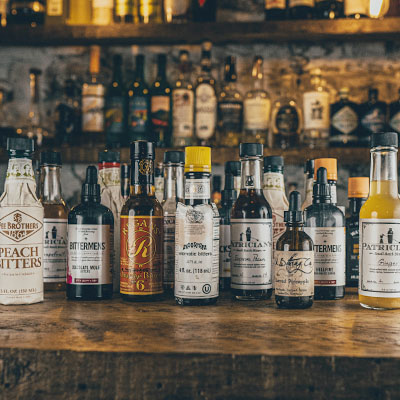
What Exactly is in Cocktail Bitters?
Bitters are made by extracting the flavors of a collection of herbs and spices into a liquid, usually high proof to maximize flavor extraction. The “bitter” part of the name comes from from a backbone made up of one or more very bitter herbs, like wormwood, gentian root, cinchona bark, and angelica.
Then other flavors layered on top of that base, using botanicals like citrus peel, cinnamon, ginger, and hundreds of other options.
A Brief History of Cocktail Bitters
Bitters were originally developed as a medicinal drink, with most of the main bittering agents thought to have benefits for digestion or a variety of ailments, such as quinine being used as an anti-malarial tonic.
These bitter tonics were mixed with sugar and other ingredients to make them more palatable, which eventually lead to the birth of the cocktail. Bitters recipes can easily range above 20 ingredients, and those recipes are closely guarded secrets.
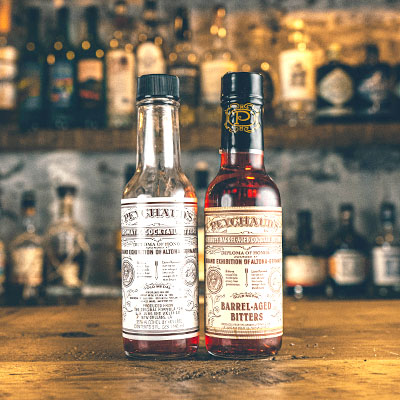
In the early 1800’s, the cocktail, what we would now call an Old Fashioned became popular. Defined as a mix of any any spirit, sugar, water, and bitters, this can be considered the birth of mixology and it’s enabled by bitters.
Driven by both supposed medicinal value and the explosion of cocktails, by the early 1900s there were many options for bitters, but most of these were lost during the dark years of Prohibition. A few survived by being made outside of the US, claiming medicinal use, or both.
The resurgence of cocktail culture starting in the late 1990’s also led to renewed interest in bitters, which in turn has led to production of many new bitters and recreations of ancient recipes for them.
What Are Aromatic Bitters? Are They The Same as Cocktail Bitters?
The most popular and famous bitters, these are what come to mind for most people when they think of bitters. The small brown bottle with the oversized white paper label is one of the most iconic and enduring images in the world of cocktails – and that bottle is Angostura Aromatic Bitters (frequently just called Angostura bitters, or Angostura, or even ango).
Functionally, the answer to the heading is yes. The term aromatic bitters in the cocktail world ties to the use of the word in the full name of Angostura bitters, and it was likely genericized from there.
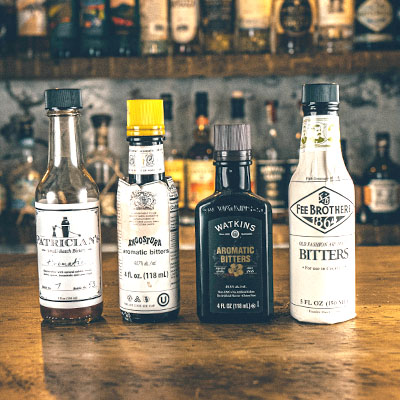
It may have also been in part to differentiate cocktail bitters them from digestive bitters, which are also commonly called by their Italian name: amaro.
Beyond the core bittering agent, these bitters use strong smelling spices as the dominant components. Angostura bitters taste profile focuses on baking spices like cinnamon and clove, as do many other aromatic bitters.
The other very famous long standing cocktail bitters brand, the classic New Orleans bitters Peychaud’s bitters uses anise and mint as the dominant aromas. Strong smelling spices, aromatic bitters. It’s a good, descriptive name.
What Are Orange Bitters ?
Speaking of descriptive names…
Orange peels are used as the flavoring agent both because the pith adds a unique bittering flavor and they are full of oils that provide a much more concentrated flavor than the actual juice of an orange.
If you’ve ever seen a piece of orange peel squeezed over a drink, what’s happening is those same oils are being sprayed out over the surface to both aromatize and subtly flavor the drink.
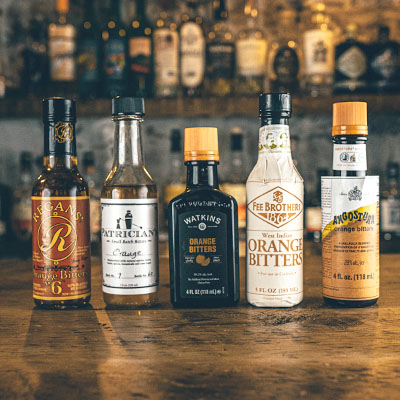
Orange bitters work on much the same principle, though all their work is strictly through flavor rather than the aroma at front of the drink.
Additional background notes frequently include other fruits or spices complementary to the dominant orange flavor, such as cardamom, coriander, cinnamon, or anise.
Looking at two of the most popular
Orange bitters have a long history in cocktails but largely fell out of use and availability until Regan re-popularized them in the 1990s. Angostura introduced its version in 2007, and now almost every brand of bitters has an orange option with other popular choices, including Fee Brothers and Bittermen’s.
Are There Other Flavors of Bitters?
The last decade has seen an huge surge in options for cocktail bitters, filling out the bartenders spice cabinet with dozens of flavors. Spicy bitters such as Bittermen’s Hellfire or cocoa bitters such as Fee Brothers Aztec Chocolate and Bittermen’s Xocalotl Mole bitters take cocktails in exciting new directions.
Tiki bitters provide a great way to give that Caribbean beach cocktail flavor to your drinks.
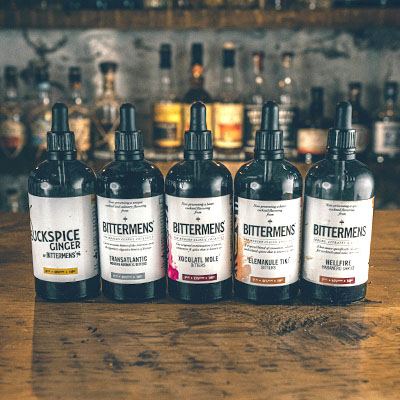
Many bitters, like the aforementioned Bittermen’s Hellfire follow the example set by
The are so many options and they all add something different to a cocktail. They are also great to use in combination, something enabled by their concentrated flavor and use in dashes which keeps them from diluting a drink.
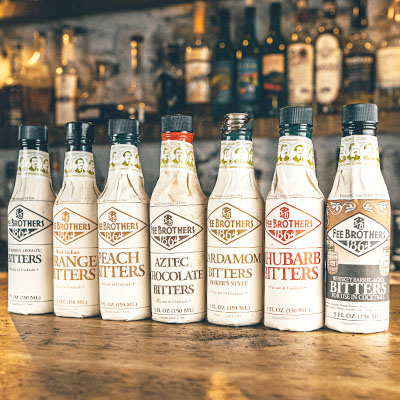
What do bitters taste like? Or, how to taste Bitters
So, how do you know what cocktail bitters you want to use? Among the myriad options, which one is going to make your drink shine?
Smell is a good place to start, after all they are aromatic. But smell doesn’t give you the whole picture, and sometimes those intense aromatics don’t come across the same when tasted. So maybe you just try a dash on your tongue?
If you’ve ever tried that, you’ll know it’s a rough way to get a sense of that flavor. Bitters are so intense that those few drops will overwhelm your taste buds and the bitter component will be so strong that most people will hate the flavor and think it can’t be used. But when diluted, some of those flavors go from awful to wonderful and the breadth of the full flavor profile can be tasted.
The best approach to understanding the pure taste of a particular bitters is to dilute a few dashes of them in soda water. I recommend 2 dashes in a 6 oz glass, preferably over ice as bitters are normally used in cold drinks. This lets you taste the bitters in isolation without having them overwhelm your taste buds.
My favorite approach to tasting bitters is not quite as good for identifying all the flavor components, but can be better for understanding how they’ll work in a drink and is way more fun. Make an Old Fashioned.
Take a whiskey you know well, keep it simple with some plain simple syrup as your sugar (I like 1/4 oz), 2 dashes of your chosen bitters, put it all over ice. This approach helps make sure you enjoy your research.
Can You Make Your Own Bitters?
Maybe you’re not getting the exact flavor you want, even with the current multitude of bitters. Or maybe you just like to do things yourself and see bitters as the logical next step in your cocktail experimentation. Whatever the reason, the thought comes to make your own bitters.
I’m happy to say that making your own bitters is both doable and fun. It can also provide you some great tinctures, individual components that go into some bitters recipes that can be as interesting to work with as bitters.
Making your own bitters can be done one of two ways. Either carefully measure all of your botanical ingredients and steep them, or steep each component separately and mix the resulting tinctures. This steeping can be done in either a neutral alcohol like vodka or Everclear, or for a more flavorful base you can use a whiskey or rum.
Further Reading on Cocktail Bitters
I can only scratch the surface here, so if you’re really interested in bitters right now, before I can write a dozen more articles on them, let me recommend some books that do a great job.
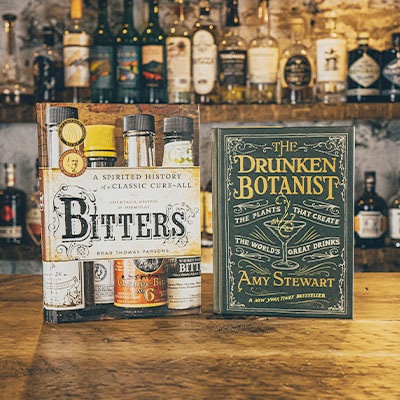
Bitters: A Spirited History of a Classic Cure-All
by Brad Thomas Parsons
This is a great place to really start your bitters journey. It’s got everything you could need – a nice history of bitters, starter recipes for making your own bitters, recipes for classic and modern cocktails with descriptions of why each one uses the bitters they do, and even how to include bitters in your cooking.
Bitters: A Spirited History of a Classic Cure-All
by Brad Thomas Parsons
This is a great place to really start your bitters journey. It’s got everything you could need – a nice history of bitters, starter recipes for making your own bitters, recipes for classic and modern cocktails with descriptions of why each one uses the bitters they do, and even how to include bitters in your cooking.




